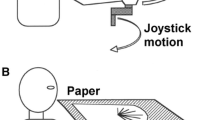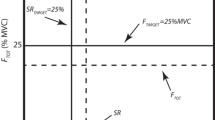Abstract
Human subjects can pre-program movements on the basis of visual cues. Experience in a particular task leads to the storage of appropriate control parameters which are used in programming subsequent movements, via a short-term motor memory. The form, duration and usage of this memory are, however, uncertain. Repetitive wrist flexion and extension movements were measured in four subjects. Three were neurologically normal men; the fourth subject had a peripheral large-fibre sensory neuropathy, depriving him of proprioceptive information about wrist movement. Subjects made alternating 45° wrist movements between two visual targets; visual feedback of wrist position was provided for the first part of each trial. After 10 s of tracking, the subjects paused for an interval of 0–24 s before resuming tracking without visual feedback of wrist position. The positional accuracy of subsequent movements was analysed with respect to pause interval. Movement accuracy was reduced by the removal of visual feedback in all four subjects: movements after the pause interval were less accurate than those before the pause. Errors also accumulated within each sequence of movements made without visual feedback. Analysis of the first movement in each trial after the pause indicated a clear relationship between movement accuracy and pause interval. In all four subjects, movement accuracy decayed with longer pause intervals. In the deafferented subject, manipulation of the visual inputs (requiring visual fixation, rather than normal pursuit of the target; or direct viewing of the hand instead of viewing a cursor on a computer screen) affected the relationship between pause interval and subsequent movement accuracy. We propose that the memory used when producing these movements is a short-lasting visuo-motor signal, lasting a few seconds, which is derived from visual knowledge of previous movements, rather than a memory of a particular motor output. This visuo-motor signal is used to scale the amplitude of subsequent wrist movements. The brevity of the visuo-motor memory and the resultant inaccuracy of this deafferented subject and of our neurologically normal subjects implies that human feedforward control of the amplitude and position of wrist movements is severely limited.
Similar content being viewed by others
References
Adams JA (1971) A closed-loop theory of motor learning. J Mot Behav 3: 111–150
Adams JA, Dijkstra S (1966) Short-term memory for motor responses. J Exp Psychol 71: 314–318
Atkeson CG, Hollerbach JM (1985) Kinematic features of unrestrained vertical arm movements. J Neurosci 5: 2318–2330
Biguer B, Prablanc C, Jeannerrod M (1984) The contribution of coordinated eye and head movements in hand pointing accuracy. Exp Brain Res 55: 462–269
Blouin J, Bard C, Teasdale N, Paillard J, Fleury M, Forget R, Lamarre Y (1993) Reference systems for coding spatial information in normal subjects and a deafferented patient. Exp Brain Res 93: 324–331
Bock O, Eckmiller R (1986) Goal-directed arm movements in absence of visual guidance: evidence for amplitude rather than position control. Exp Brain Res 62: 451–458
Bock O, Arnold K (1993) Error accumulation and error correction in sequential pointing movementrs. Exp Brain Res 95: 111–117
Box GEP, Andersen SL (1955) Perturbation theory in the derivation of robust criteria and the study of departures from assumptions. J R Stat Soc [B] 17: 1–26
Cole JD (1991) Pride and a daily marathon. Duckworth, London
Cole JD, Sedgwick EM (1992) The perception of force and of movement in a man without large myelinated sensory afferents below the neck. J Physiol (Lond) 449: 503–515
Cordo PJ (1990) Kinesthetic control of a multijoint movement sequence. J Neurophysiol 63: 161–172
Cordo PJ, Schieppati M, Bevan L, Carlton LG, Carlton MJ (1993) Central and peripheral coordination in movement sequences. Psychol Res 55: 124–130
Darling WG, Miller GF (1993) Transformations between visual and kinesthetic coordinate systems in reaches to remembered object locations and orientations. Exp Brain Res 93: 534–547
Delreux V, Abeele S van den, Crommelinck M, Roucoux A (1991) Interactions between goal-directed eye and arm movements: arguments for an interdependent motor control. J Mot Behav 23: 147–151
Dick MB, Kean ML, Sands D (1988) The preselection effect on the recall facilitation of motor movements in Alzheimer-type dementia. J Gerontol 43: 127–135
Donkelaar P van, Lee RG, Gellman RS (1994) The contribution of retinal and extraretinal signals to manual tracking movements. Exp Brain Res 99: 155–163
Ghez C, Gordon J, Ghilardi MF, Christakos CN, Cooper SE (1990) Roles of proprioceptive input in the programming of arm trajectories. Cold Spring Harb Symp Quant Biol 55: 837–847
Ghez C, Gordon J, Ghilardi MF (1995) Impairments of reaching movements in patients without proprioception. II. Effects of visual information on accuracy. J Neurophysiol 73: 361–372
Gordon AM, Inhoff AW (1992) Intermittent use of feedback during movement phase transitions and during the updating of internal models. Behav Brain Sci 15: 748
Keele SW, Posner MI (1968) Processing of visual feedback in rapid movements. J Exp Psychol 77: 155–158
Keele SW (1968) Movement control in skilled motor performance. Psychol Bull 70: 387–403
Kohler J, Isenberg C, Schonle PW, Inbar GF, Conrad B (1989) The role of short-term visuo-spatial memory in control of rapid multi-joint prehensive movements. Eur Arch Psychiatr Neurol Sci 238: 189–195
Laabs GJ (1973) Retention characteristics of different reproduction cues in motor short-term memory. J Exp Psychol 100: 168–177
Lacquaniti F, Borghese NA, Carrozzo M (1992) Internal models of limb geometry in the control of hand compliance. J Neurosci 12: 1750–1762
LaRue J, Fleury M, Blouin J, Bard C, Paillard J, Teasdale N, Forget R, Lamarre Y (1991) Arm movement control in a deafferented patient. IBRO, Montreal, August 1991, P3918, p 261
Lee RG, Tatton WG (1978) Long-loop reflexes in man: clinical applications. In: Desmedt JE (ed) Cerebral Motor Control in Man: Long Loop Mechanisms. Progress in Clinical Neurophysiology, vol 4. Karger, Basel & London, pp 320–333
Miall RC (1994) Short-term “motor memory” for wrist movement in a deafferented subject depends on visual coordinates (abstract). 4th Conference on Neural Control of Movement, Maui, Hawaii
Miall RC, Haggard PN, Stein JF, Cole JD (1993) Evidence of a limited motor memory for wrist movement in a subject with peripheral neuropathy (abstract). J Physiol (Lond) 473: 211P
Miall RC, Weir DJ, Stein JF (1985) Visuo-motor tracking with delayed visual feedback. Neuroscience 16: 511–520
Nemire K, Bridgeman B (1987) Oculomotor and skeletal motor systems share one map of visual space. Vision Res 27: 393–400
Newell KM (1991) Motor skill acquisition. Annu Rev Psychol 42: 213–237
Paillard J, Brouchon M (1968) Active and passive movements in the calibration of position sense. In: Freedman SJ (ed) The neuropsychology of spatially oriented behaviour. Dorsey, Illinois, pp 37–56
Pasquier F, Linden M van der, Le Febvre V, Le Febvre C, Bruyer R, Petit H (1994) Motor memory and the preselection effect in Huntingdon's and Parkinson's Disease. Neuropsychologia 32: 951–968
Polit A, Bizzi E (1979) Characteristics of motor programs underlying arm movements in monkeys. J Neurophysiol 42: 183–194
Prablanc C, Echallier JF, Komilis E, Jeannerod M (1979) Optimal response of eye and hand motor systems in pointing. I. Spatiotemporal characteristics of eye and hand movements and their relationships when varying the amount of visual information. Biol Cybern 35: 113–124
Prablanc C, Pelisson D, Goodale MA (1986) Visual control of reaching movements without vision of the limb. I. Role of retinal feedback of target position in guiding the limb. Exp Brain Res 62: 293–302
Rothwell JC, Traub MM, Day BL, Obeso JA, Thomas PK, Marsden CD (1982) Manual motor performance in a deafferented man. Brain 105: 515–452
Sanes JN, Mauritz K-H, Dalakas MC, Evarts EV (1985) Motor control in humans with large-fiber sensory neuropathy. Hum Neurobiol 4: 101–114
Sanes JN, Mauritz KH, Evarts EV, Dalakas MC, Chu A (1984) Motor deficits in patients with large-fiber sensory neuropathy. Proc Nat Acad Sci USA 81: 979–982
Schmidt RA (1975) A schema theory of discrete motor skill learning. Psychol Rev 82: 225–260
Schmidt RA, Zelaznik HN, Hawkins B, Frank JS, Quinn JT Jr (1979) Motor output variability: a theory for the accuracy of rapid motor acts. Psychol Rev 86: 415–451
Smith WM, Bowen KF (1980) The effects of delayed and displaced visual feedback on motor control. J Mot Behav 12: 91–101
Soechting JF, Flanders M (1989) Sensorimotor representations for pointing to targets in three-dimensional space. J Neurophysiol 62: 582–594
Thompson JA (1983) Is continuous visual monitoring necessary in visually guided locomotion? J Exp Psychol Hum Percept 9: 427–443
Vercher JL, Magenes G, Prablanc C, Gauthier GM (1994) Eyehead-hand coordination in pointing at visual targets: spatial and temporal analysis. Exp Brain Res 99: 507–523
Wann JP, Ibrahim SF (1992) Does limb proprioception drift? Exp Brain Res 91: 162–166
Weir DJ, Stein JF, Miall RC (1989) Cues and strategies in a visuomotor tracking task. J Mot Behav 21: 185–204
Author information
Authors and Affiliations
Rights and permissions
About this article
Cite this article
Miall, R.C., Haggard, P.N. & Cole, J.D. Evidence of a limited visuo-motor memory used in programming wrist movements. Exp Brain Res 107, 267–280 (1995). https://doi.org/10.1007/BF00230047
Received:
Accepted:
Issue Date:
DOI: https://doi.org/10.1007/BF00230047




